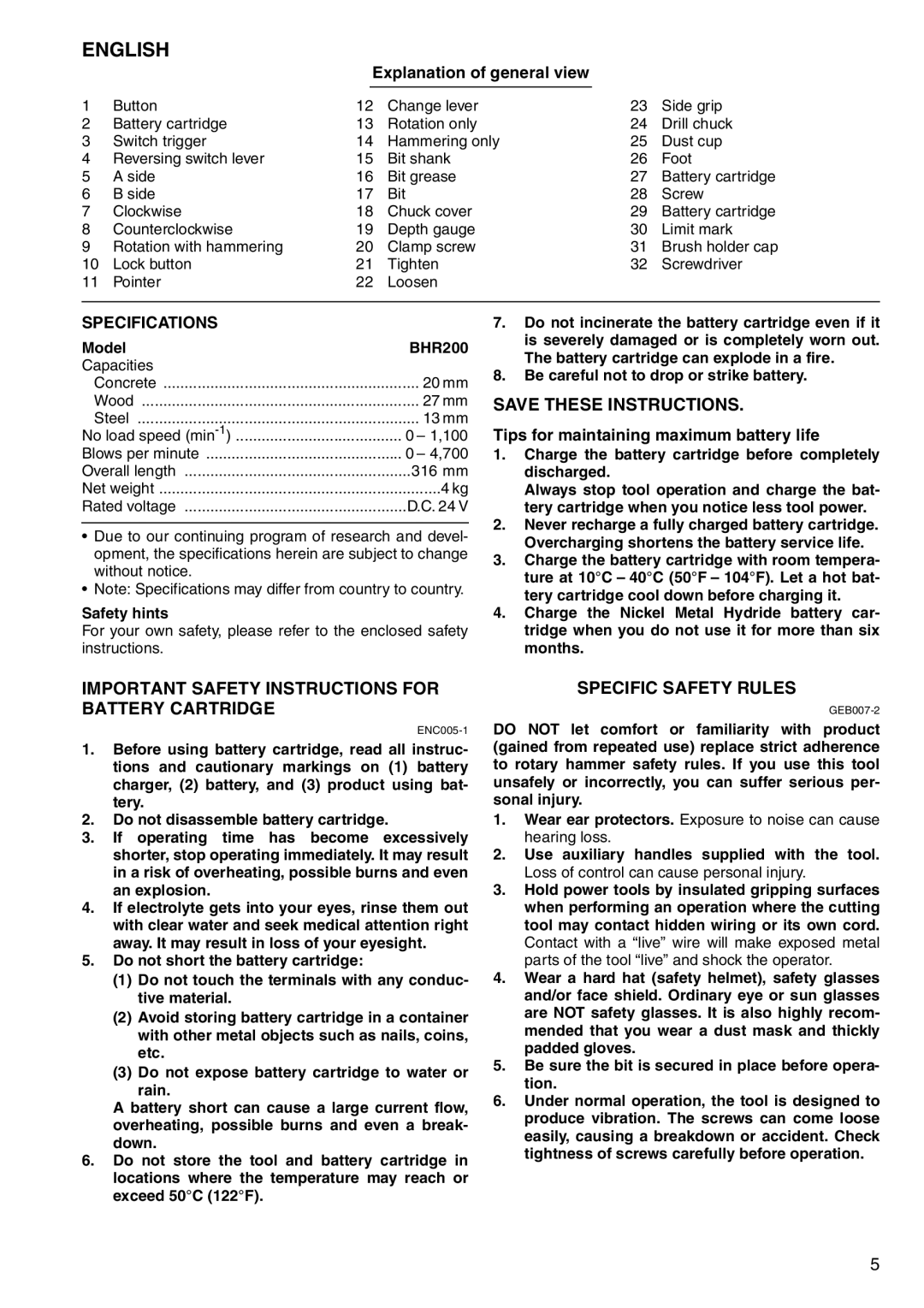
ENGLISH
Explanation of general view
1 | Button | 12 | Change lever | 23 | Side grip |
2 | Battery cartridge | 13 | Rotation only | 24 | Drill chuck |
3 | Switch trigger | 14 | Hammering only | 25 | Dust cup |
4 | Reversing switch lever | 15 | Bit shank | 26 | Foot |
5 | A side | 16 | Bit grease | 27 | Battery cartridge |
6 | B side | 17 | Bit | 28 | Screw |
7 | Clockwise | 18 | Chuck cover | 29 | Battery cartridge |
8 | Counterclockwise | 19 | Depth gauge | 30 | Limit mark |
9 | Rotation with hammering | 20 | Clamp screw | 31 | Brush holder cap |
10 | Lock button | 21 | Tighten | 32 | Screwdriver |
11 | Pointer | 22 | Loosen |
|
|
|
|
|
|
|
|
SPECIFICATIONS
Model | BHR200 |
Capacities |
|
Concrete | 20 mm |
Wood | 27 mm |
Steel | 13 mm |
No load speed | 0 – 1,100 |
Blows per minute | 0 – 4,700 |
Overall length | 316 mm |
Net weight | 4 kg |
Rated voltage | D.C. 24 V |
•Due to our continuing program of research and devel- opment, the specifications herein are subject to change without notice.
•Note: Specifications may differ from country to country.
Safety hints
For your own safety, please refer to the enclosed safety instructions.
IMPORTANT SAFETY INSTRUCTIONS FOR BATTERY CARTRIDGE
1.Before using battery cartridge, read all instruc- tions and cautionary markings on (1) battery charger, (2) battery, and (3) product using bat- tery.
2.Do not disassemble battery cartridge.
3.If operating time has become excessively shorter, stop operating immediately. It may result in a risk of overheating, possible burns and even an explosion.
4.If electrolyte gets into your eyes, rinse them out with clear water and seek medical attention right away. It may result in loss of your eyesight.
5.Do not short the battery cartridge:
(1)Do not touch the terminals with any conduc- tive material.
(2)Avoid storing battery cartridge in a container with other metal objects such as nails, coins, etc.
(3)Do not expose battery cartridge to water or rain.
A battery short can cause a large current flow, overheating, possible burns and even a break- down.
6.Do not store the tool and battery cartridge in locations where the temperature may reach or exceed 50°C (122°F).
7.Do not incinerate the battery cartridge even if it is severely damaged or is completely worn out. The battery cartridge can explode in a fire.
8.Be careful not to drop or strike battery.
SAVE THESE INSTRUCTIONS.
Tips for maintaining maximum battery life
1.Charge the battery cartridge before completely discharged.
Always stop tool operation and charge the bat- tery cartridge when you notice less tool power.
2.Never recharge a fully charged battery cartridge. Overcharging shortens the battery service life.
3.Charge the battery cartridge with room tempera- ture at 10°C – 40°C (50°F – 104°F). Let a hot bat- tery cartridge cool down before charging it.
4.Charge the Nickel Metal Hydride battery car- tridge when you do not use it for more than six months.
SPECIFIC SAFETY RULES
DO NOT let comfort or familiarity with product (gained from repeated use) replace strict adherence to rotary hammer safety rules. If you use this tool unsafely or incorrectly, you can suffer serious per- sonal injury.
1.Wear ear protectors. Exposure to noise can cause hearing loss.
2.Use auxiliary handles supplied with the tool. Loss of control can cause personal injury.
3.Hold power tools by insulated gripping surfaces when performing an operation where the cutting tool may contact hidden wiring or its own cord. Contact with a “live” wire will make exposed metal parts of the tool “live” and shock the operator.
4.Wear a hard hat (safety helmet), safety glasses and/or face shield. Ordinary eye or sun glasses are NOT safety glasses. It is also highly recom- mended that you wear a dust mask and thickly padded gloves.
5.Be sure the bit is secured in place before opera- tion.
6.Under normal operation, the tool is designed to produce vibration. The screws can come loose easily, causing a breakdown or accident. Check tightness of screws carefully before operation.
5
